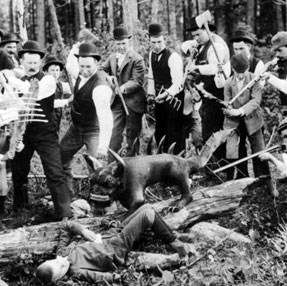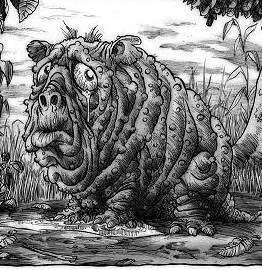Fearsome Critters of American Folklore

The Fearsome Critters are a group of mythical beings from the stories told by European colonists to North America, mainly in New England (naturally) in the 19th and early 20th centuries, but there are stories of Fearsome Critters spread all across the country, including several notable "species" specific to the southwest. Fearsome Critters are notable for being described primarily by their behavior, not by their appearance, and for often having names that reflect that (Hide-Behind, Come-at-a-Body, et cetera), meaning that what they actually look like fluctuates wildly from tale to tale in the style of Paul Bunyan—whose loyal friend and partner, Babe the Big Blue Ox, might well be a Critter himself.
Genuine belief in the Fearsome Critters was never widespread; even in most of modern America they're relatively obscure, and almost completely unheard-of in other parts of the world. They originated, variously, as exaggerated accounts of native fauna unfamiliar to the European travelers who described them and as a humorous means of describing the strange goings-on in the woods by lumberjacks, carnies, and other outdoorsy types. Fearsome critters are not cryptids, nor are they associated with Native American faiths; the Jersey Devil, the sasquatch and the Wendigo are not Fearsome Critters.
Some of the notable Critters are:
The Guyascutus

Known by a myriad of other names, including the Guyanoosa and Sidehill Gouger, the Guyascutus is a terrible predator variously described as being like an alligator covered in protective plates, like an armadillo's, or like a deer with the ears of a rabbit and a mouth full of fierce teeth. Its most notable feature, however, is that the legs on one side of its body are much shorter than the ones on the other, so it can move about easily on the steep mountain slopes where it makes its home; therefore, to escape a Guyascutus, one need only run onto even ground. The creature, with its mismatched legs, will be unable to follow.
The most famous legend of the Guyascutus involves an old carnival grift. A traveling carnival show rolls into town, claiming to have wild animals from all around the world on display—including, incredibly, a live Guyascutus. The people paid their fees and flocked to see the alleged beastie, at which point the leader of the plan would run before the crowds, looking desperate and beat-up, claiming that the creature had escaped. The people, terrified, would immediately run to their homes, leaving the carnival troupe to ride away with their "earnings".
The Squonk

Perhaps the most famous of the bunch (and the subject of more than one popular song), the Squonk is a miserable animal, "The most melancholy of creatures", that allegedly inhabits the coniferous forests of northern Pennsylvania. Because its skin is covered in warts, blemishes, blisters and abrasions, the Squonk is disgusting to look at—and it knows this, which is why it hides underground during the day, hoping not to offend any other creature with its hideous appearance. At night, the Squonks all come out into the open and openly weep; the strange sounds lumberjacks and other frontiersmen heard in the forest at night were attributed to their crying.
The Squonk also has a legend surrounding it. This one tells of a man named J.P. Wentling, who wanted to capture a live Squonk and prove its existence to the world. One night he succeeded, trapping the creature in a bag; but when he took it home and opened the bag to show his friends and family, he found nothing but water inside. The Squonk, more miserable than ever, had dissolved into a pool of its own tears.
The Jackalope

The most famous southwestern Critter, popular in Texas, New Mexico, and southern California. The Jackalope is a wild hare or jackrabbit with the antlers of a deer, reportedly very difficult to catch or even to spot (though U.S. President Ronald Reagan did claim to have caught one once—purely as a joke, we expect). Jackalopes are highly elusive and will run at the very sight of a human, but at night, they all gather in the desert and sing harmoniously with their strange, enchanting voices. Of course, that's only one interpretation; it's more uncommonly described as a vicious Killer Rabbit. To this day, the "stuffed Jackalope" is a fairly common sight in southwestern bars and taverns.
Sadly, any reported Jackalope sighting is much more likely to be a regular rabbit afflicted with the shope papilloma virus.
The Hodag Still quite popular in Wisconsin, where it makes its home (and particularly in the city of Rhinelander), the Hodag is a fierce beastie with "the head of a frog, the grinning face of a giant elephant, thick short legs set off by huge claws, the back of a dinosaur, and a long tail with spears at the end". Several hoaxes regarding the animal, from the way it terrorized the lumber community to its eventual capture (using chloroform and dynamite, no less!) were perpetrated in the late 19th century by the prankster Eugene Shepard. Today, the creature is more or less a fondly-regarded local curiosity; it's even become the mascot of Rhinelander High School.
Others Lesser-known (but no less Fearsome) Critters:
- The Axehandle Hound, a scraggly white dog that feeds on axe handles left unattended in the woods at night; described by Jorge Luis Borges in the Book of Imaginary Beings.
- The Argopelter, a little-seen forest creature that hides among the trees and throws sticks and stones at anyone intending to cut down its home.
- The Bildad, a strange cross of beaver and waterfowl; it's so quick, it can dive into the water and catch a fish before it even makes a splash.
- The Cactus Cat, which is pretty much exactly what you're imagining, and may or may not feed on peyote.
- The Fur-Bearing Trout, a fish that grows a downy white coat to survive cold winters in the Great Lakes.
- The Gillygaloo, a bird that inhabits the Pyramid Forty built by Paul Bunyan; it lays cube-shaped eggs, which are hard-boiled by outdoorsmen and used as gaming dice.
- The Glawackus, a mixture of every (real) dangerous predator that stalks northeastern the American wilderness.
- The Goofus Bird, a bird that flies backwards because it likes to see where it's been, not where it's going; maintaining the "backwards" theme, the Goofus Bird builds upside-down, igloo-shaped nests on tree branches, with the eggs resting on the ceiling. Nobody ever figured out how it managed to do it.
- The Hide-Behind is generally impossible to physically describe, as it's always hiding behind something: a tree, a rock, your chair as you read this entry..
- The Hoop Snake, a shy creature that bites its own tail and rolls away like a wheel at the sight of danger.
- The Joint Snake, a snake that can split into many different segments that each go their own way when it's threatened; it does not, as far as we know, enjoy marijuana.
- The Lucive, or Loup-Cervier, which looks like an adorable fawn but is in fact a bloodthirsty predator with the terrible jaws of a wolf.
- The Snow Snake, a vicious white reptile that hides in the snow with only its pink eyes sticking out, stalking (often human) prey.
- The Splinter Cat, a cat with a hard skull it uses to slam against tree trunks and knock its food from the branches above.
- The Teakettler, a little vermin that infests tea kettles and makes them rattle incessantly through the night.
- The Wunk is a retiring critter that hides by digging a hole, jumping in, and then pulling the hole in after it.
Film
- Brotherhood of the Wolf has the lead character show the Fur Bearing Trout to french aristocrats until one catches onto the forgery. It allows him to talk about his theory on the nature of the Wolf.
Literature
- A 1996 short story by Nancy Springer titled "Byrd Song" centers around an outcast girl who meets a Squonk, and was published in Bruce Coville's Book of Magic.
- Several critters appear in the McBroom series by Sid Fleischman, notably McBroom's Zoo. They include the Desert Goo-fang, the Compass Cat, and the Great 17-Toed Hairy Prairie Hidebehind.
- Several of Manly Wade Wellman's John the Balladeer stories; particularly "The Desrick on Yandro", which features several varieties of Critter. John himself is the only man ever to have seen the Behinder and lived (it was concentrating on being behind someone else at the time); he declines to describe it, saying only that he'd have been happier not to have had to look at it.
- Alvin Schwartz's children's book Kickle Snifters and Other Fearsome Critters is a bestiary of these beings.
- The eponymous subject of the James Whitcomb Riley poem "The Raggedy Man" is an expert in this field of study.
Music
- The song 'Squonk' by Genesis is entirely about the title creature and the famous legend that surrounds it: a man manages to capture the elusive being, trapping it in a bag; however, when he tries to show off his find to others, he finds that his bag is full of water. The Squonk, morose, has dissolved into its own tears.
- A line from Steely Dan's song 'Any Major Dude Will Tell You': "Have you ever seen a Squonk's tears? / Well, look at mine"
- Rapper MC Frontalot mentions the creature in the song 'Scare Goat', with the lines "Got a Mongolian Death Worm at my house, right next to Squonk and the Aqueous Mouse..."
- A Canadian industrial music band has named itself for the animal, using the spelling Jakalope.
- Composer Don Bodin recorded a song called "Ghost of the Jackalope" on his fourth studio album, "The Radioactive Werewolf."
Newspaper Comics
- Bloom County went one further and had a bassalope—basset hound plus Jackalope.
Tabletop Gaming
- Magic: The Gathering features a card called "Jackalope Herd".
- Mortasheen has the Sqwunk, based on the Squonk.
- Dungeons & Dragons got Remorhaz - a huge worm-like ambush predator hiding under snow, much like Snow Snake.
- Rogue Trader has Creeping Stalker - a great worm-like creature found on an ice world, hiding in (part-methane) snow.
Video Games
- The PlayStation 2 game Culdcept features the Squonk as a playable creature card.
- In Rampage: Total Destruction, there is a monster known as Jack the Jackalope.
- "Sam & Max: On The Road" described jackalopes as the bastard sons of Piltdown Man.
Western Animation
- The Pixar short Boundin features a sheep, despondent after having been sheared of his wool, receiving comfort and wisdom from a passing "Great American Jackalope".
- One episode of Tiny Toon Adventures featured a monstrous Jackalope named One-Eyed Jack.
- One episode of Earthworm Jim featured the Giant Fur-Bearing Trout, an ancient being of sacred wisdom.
- A Hodag appears as a monster of the week in Season 2 of Scooby Doo Mystery Incorporated